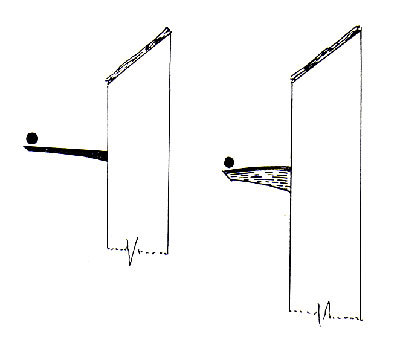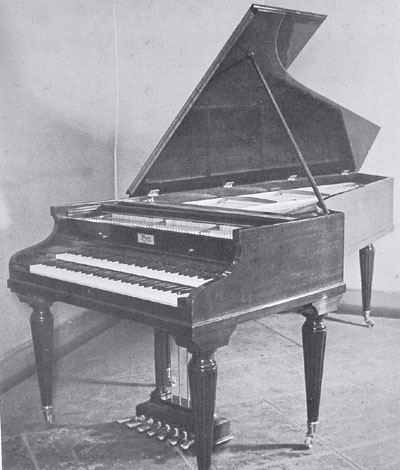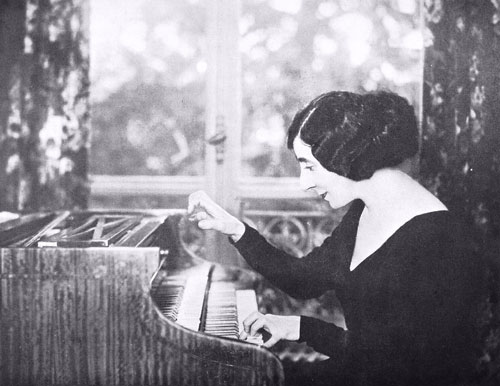Edward L. Kottick - ed@kottick.com
University of Iowa, Emeritus
502 Larch Lane, Iowa City, IA 52245
Popular version of paper 4pMU7
Presented Thursday afternoon, May 27, 2004
147th ASA Meeting, New York, NY
Despite its honorable 400-year history, by 1800 the harpsichord had been shoved aside by that upstart, the piano. But the harpsichord was not entirely forgotten. Some collectors began to accumulate antique harpsichords precisely because they were old. Some were restored, and a few were played in concerts by pianists trying to recreate earlier music. With a fresh but old sound, the instrument also offered an attractive option to composers. By the end of the 19th century there was enough interest in the harpsichord to suggest that it might be time to resurrect it.
1889 Harpsichord by Pleyel

Accordingly, in 1889 visitors to the Paris Exhibition were introduced to three modern versions of the ancient instrument. The Exposition was only the beginning: modern English harpsichord building began shortly thereafter, in 1896; in Germany it started in 1899, and in the United States in 1909. By 1929 the instrument was firmly re-established in Western musical culture. Still, that 1929 harpsichord was everything the 18th-century instrument was not.
Chart of Classical Antiques and Revival Harpsichords| Classical antiques | Revival harpsichords |
|
Scales ca. 14” |
Scales ca. 15”-17” Steel and spring brass wire Soundboards ca. 1/4” thick Heavy ribbing Heavy beam-like framing Open bottoms Weighted jacks Heavy leather plectra Jacks fully adjustable Heavy keyboards, bushed with felt |
On those 1929 harpsichords scales (the "scale is the length of the note C above middle C, and all other string lengths are derived from it) were several inches longer than those of the classical instrument, necessitating the use of modern steel and spring brass wire at high tension. But in the bass the strings were shorter, requiring the use of flabby overwound strings. This scheme produced a dull tone with few upper partials throughout most of the compass, with muddy sounds coming from the short overwound bass strings.
Classical harpsichord soundboards were no more than 1/8" thick, and lightly ribbed. But with the long scales and high tension of 1929 instruments, such a board would have collapsed; consequently, most revival soundboards were twice as thick, and heavily barred, in piano fashion. Since it was almost impossible to get such heavy, encumbered boards to vibrate freely, comparatively little sound emanated from them.
Most classical harpsichord cases were well braced to withstand the relatively low tensions produced by their shorter scales, but they could never have stood up to the dramatic increase in tension with long scales and steel strings. Accordingly, case rims of revival harpsichords were of piano thicknesses and heavily braced, often with a series of beams.
The classical jack was simple: a slip of wood, slightly tapered in both width and breadth, so that it fit tightly in its guides when in its rest position, but loosely when elevated by the key. Early 20th-century jacks were manufactured to close tolerances, without the tapering, assuring that they would stick in their guides with the slightest speck of dust or change in humidity. To counteract this, weights were added to the jacks, thus prohibiting the lightness and suppleness of touch so prized in the classical instruments.
Quill and Leather Plectra

The plectra for these jacks were made of chunks of hard leather, since something
fairly massive was necessary to get the high-tension strings into vibration.
The classical harpsichord had light, unbushed keys. Such a keyboard would not
have been able to drive high-tension strings, heavy jacks, and thick leather
plectra, so weighty piano-style keys with felt bushings were used.
This combination of heavily-built keyboard, jacks, plectra, strings, soundboard, and case, assured that the classical harpsichord's supple action, with its ability to phrase, articulate, and even produce limited dynamic effects, was completely lost. Not surprisingly, the dull sound of these harpsichords bore little resemblance to the antiques. But this was not considered a problem. If the harpsichord was to be accepted as a contemporary instrument, it would do so on its own, 20th-century terms, with its own, 20th-century sound. Granted, that sound was thin and uninteresting, but it was understood that some sacrifices had to be made if the instrument was to be brought up to date.
Pleyel Grand Modèle de Concert

Probably the finest example of the revival maker's art, incorporating all these
"improvements," was the Grand Modèle de Concert harpsichord
the Pleyel piano company made for the great Wanda Landowska, and which first
appeared (with a cast-iron frame) in 1923. Although the Grand Modèle
was considered a marvel of modern instrument design, it was unable to live up
to its publicity. It was far more complex than it needed to be, and in constant
need of regulation. But even when working at peak efficiency the sound level
and presence of a Pleyel was far from that of a well-restored antique. What
is surprising is not how badly this instrument failed, but how difficult it
was for people to see its problems. The Pleyel seems to have been a perfect
example of a modern-day version of "The Emperor's New Clothes," or
more correctly, "The Empress' New Clothes."
Wanda Landowska

In 1929 the Empress of the harpsichord was Wanda Landowska. She was a highly
admired artist, and not without reason. She had an amazing technique and she
had great star quality, so it was not unexpected for her instrument to be as
admired as she. Also, the Pleyel recorded well, spreading the perception that
it was a powerful and colorful instrument. In real life, however, its sound
was thin and disappointing. Still, the legend of Landowska and her Pleyel was
so strong that people convinced themselves they were hearing something special.
In large part due to Landowska and her Grand Modèle Pleyel, the harpsichord
had completed a triumphant comeback by the outset of World War II. It was no
longer an exotic instrument from the distant past. It was recognized as a modernized
version of an instrument whose presence was now accepted as a historical imperative.
Harpsichord building was halted during the war, but within five years after the end of the hostilities a new breed of builders arose, who attempted to emulate the building practices of the old masters. The results were startling. Their instruments produced more volume, they looked more graceful, they were easier to tune and maintain, their sound was more attractive and more useful, and their relatively simple dispositions served the music better than the complex revival models. The defining moment for the harpsichord in the mid-20th Century came at the second of the international exhibitions that took place in Bruges, Belgium. At the first, in 1965, the German factory instruments dominated; but three years later the revolution had already occurred, and the factory harpsichords showed poorly when pitted against the historically based instruments. Thus, the 1968 Bruge festival, coming 79 years after the Paris exposition, marked the beginning of the end of the revival harpsichord and the beginning of the hegemony of the historically-derived modern instrument.
The harpsichord revival began with the construction of an all-purpose harpsichord, and the sound of that instrument was accepted as "the harpsichord" in 1929 Today we not only distinguish between Italian, Flemish, French, English, German, and Iberian harpsichords, we recognize that there are distinct differences between the 16th, 17th, and 18th-century versions of these regional styles.
Sound file-musical examples
1. 17th-Century Flemish
2. 18th-Century French
3. 18th-Century German
4. Pleyel Grand Modèle de Concert (ca.
1929)